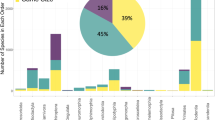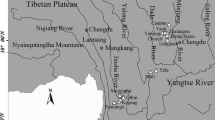Summary
We analysed sexual size dimorphism for 21 populations of microtine rodents. Female to male size ratio varied considerably among populations from females significantly larger than males (ratio=1.18) to males larger than females (ratio=0.78). In a multiple regression analysis female to male home range size ratio explained 94% of the total variation in body size dimorphism and was the only one of eight independent variables that was selected in a stepwise regression procedure. When females are the larger sex, males have home range sizes much larger than females. We suggest that the relationship between home range size ratio and body weight size dimorphism reflects different selection pressures on males and females in competition for resources and mates.
Similar content being viewed by others
References
Aitchinson, C. W. (1987a) Review of winter trophic relations of soricine shrews.Mammal Rev. 17, 1–24.
Aitchinson, C. W. (1987b) Winter energy requirements of soricine shrews.Mammal Rev. 17, 25–38.
Banfield, A. W. F. (1974)The mammals of Canada. pp. 438. Toronto: Univ. Toronto Press.
Batzli, G. O. (1985) Nutrition. (R. H. Tamarin, ed.)Biology of New World Microtus. pp. 779–811. Sp. Publ. No. 8.Am. Soc. Mamm.
Bergsted, B. (1966) Home range and movements of the rodent speciesClethrionomys glareolus (Schreber),Apodenus flavicolis (Melchoir) andApodemus sylvaticus (Linne) in southern Sweden.Oikos 17, 150–7.
Bondrup-Nielsen, S. (1987) Demography ofClethrionomys gapperi in different habitats.Can. J. Zool. 65, 277–83.
Bondrup-Nielsen, S. (in press). Food choice and diet of wood lemmings,Myopus schisticolor. Biol. J. Linn. Soc.
Bondrup-Nielsen, S. and Karlsson, F. (1985) Movements and spatial patterns in populations ofClethrionomys species, A review.Ann Zool. Fennici 22, 385–92.
Bondrup-Nielsen, S. and Ims, R. A. (1988) Demography during a population crash of the wood lemming,Myopus schisticolor.Can. J. Zool. 67, 2442–8.
Bondrup-Nielsen, S., Ims, R. A., Fredriksson, R. and Fredga, K. (in press). Demography of the wood lemmingMyopus schisticolor Biol. J. Linn. Soc.
Chitty, H. and Chitty, D. (1962) Body weight in relation to population phase inMicrotus agrestis. Symp. Theriologicum. Berno, 1962, pp. 77–86.
Clutton-Brock, T. H. and Harvey, P. H. (1983) The functional significance of variation in body size among mammals. (J. K. Eisenberg and D. G. Kleiman, eds)Advances in the study of mammalian behavior. pp. 632–63. Spec. Publ. No. 7.Amer. Soc. Mamm.
Clutton-Brock, T. H. and Iason, G. R. (1986) Sex ratio variation in mammals.Quart. Rev. Biol. 61, 339–74.
Crawley, M. C. (1969) Movements and home-ranges ofClethrionomys glareolus Schreber andApodemus sylvaticus L. in north-east England.Oikos 20, 310–19.
Davies, N. B. and Houston, A. I. (1984) Territory economics. (J. R. Krebs and N. B. Davies, eds)Behavioural Ecology, An evolutionary approach. pp. 148–69. Oxford: Blackwell Scientific Publications.
Dewsbury, D. A., Baumgardner, D. J., Evans, R. L. and Webster, D. G. (1980) Sexual dimorphism for body mass in 13 taxa of muroid rodents under laboratory conditions.J. Mamm. 61, 146–9.
Eisenberg, J. F. (1981)The mammalian radiation,. Chicago: The University of Chicago Press.
Fuller, W. A. (1985)Clethrionomys gapperi, Is there a peak syndrome?Ann. Zool. Fennici 22, 243–55.
Getz, L. L. (1985) Habitats. (R. H. Tamarin, ed.)Biology of New World Microtus. pp. 286–309. Sp. Publ. No. 8.Am. Soc. Mamm.
Grodzinski, W. (1985) Ecological energetics of bank voles and wood mice (J. R. Flowerdew, J. Gurnell and J. H. W. Gipps, eds)The ecology of woodland rodents, bank voles and wood mice. pp. 169–92.Symp. Zool. Soc. Lond. No. 55, London.
Hansson, L. (1985)Clethrionomys food, generic, specific and regional characteristics.Ann. Zool. Fennici 22, 315–18.
Healing, T. D. (1984) Factors affecting the population dynamics of the Skomer vole.Clethrionomys glareolus skomerensis. Unpubl Ph.D. thesis, London University.
Heske, E. J. (1987) Spatial structuring and dispersal in a high density population of the California voleMicrotus californicus.Holarct Ecol. 10, 137–48.
Ims, R. A. (1987a) Responses in spatial organization and behaviour to manipulation of the food resource in the voleClethrionomys rufocanus.J. Anim. Ecol. 56, 585–96.
Ims, R. A. (1987b) Determinants of competitive success inClethrionomys rufocanus.Ecology 68, 1812–18.
Ims, R. A. (1987c) Male spacing systems in microtine rodents.Am. Nat. 130, 475–84.
Ims, R. A. (1988) Spatial clumping of sexually receptive females induces space sharing among male voles.Nature 335, 541–3.
Ims, R. A. (1990) Mate detection success of maleClethrionomys rufocanus in relation to the spatial distribution of sexually receptive females.Evol. Ecol. 4, 57–61.
Ims, R. A., Bondrup-Nielsen, S. and Stenseth, N. C. (1988) Temporal patterns of breeding events in small rodent populations.Oikos 52, 178–85.
Iverson, S. L. and Turner, B. N. (1976) Small mammal radioecology, natural reproductive patterns of seven species.Atomic Energy of Canada Report. Whiteshell Nuclear Research Establishment, Pinawa, Manitoba, AECL-5393, 53 pp.
Kalela, O. and Oksala, T. (1966) Sex ratio in the wood lemmingMyopus schisticolor (Lilljeb.), in nature and captivity.Annales Universitatis Turkuensis II. Biologica-Geographica 37, 5–24.
Keller, B. L. (1985) Reproductive patterns. (R. H. Tamarin, ed.)Biology of New World Microtus. pp. 725–811. Sp. Publ. No. 8.Am. Soc. Mamm.
Kleiman, D. G. (1977) Monogamy in mammals.Quart. Rev. Biol. 52, 39–69.
Koshkina, T. V. (1961) Nye data om lemmen (Lemmus lemmus) næringsvaner.Bull. Mosk. Obsch. Ispyt. Prirody. Otd. Biol. Vol. 66(6). Translated to Norwegian from Russian by Jadwiga Weber.
Lindstedt, S. L., Miller, B. J. and Buskirk, S. W. (1986) Home range, time and body size in mammals.Ecology 67, 413–18.
Madison, D. M. (1985) Activity rhythms and spacing. (R. H. Tamarin, ed.)Biology of New World Microtus. pp. 373–419. Sp. Publ. No. 8.Am. Soc. Mamm.
Myllymäki, A. (1977) Demographic mechanisms in the fluctuating populations of the field voleMicrotus agrestis.Oikos 29, 468–93.
Ostfeld, R. S. (1985) Limiting resources and territoriality in microtine rodents.Am. Nat. 126, 1–15.
Ostfeld, R. S. (1986) Territoriality and mating systems of California voles.J. Anim. Ecol. 55, 691–706.
Peters, R. H. (1983)The ecological implications of body size. Cambridge: Cambridge University Press.
Pucek, M. (1983) Habitat of the population (K. Petrusewicz, ed.)Ecology of the bank vole.Acta Theriol. pp. 31–9., vol. 28. Suppl. 1.
Ralls, K. (1976) Mammals in which females are larger than males.Quart. Rev. Biol. 51, 245–76.
Ralls, K. (1977) Sexual dimorphism in mammals: avian models and unanswered questions.Am. Nat. 111, 917–38.
Reiss, M. J. (1986) Sexual dimorphism in body size: are large species more dimorphic?J. Theor. Biol. 121, 163–72.
Reiss, M. (1988) Scaling of home range size, body size, metabolic needs and ecology.Trends Ecol. Evol. 3, 85–6.
Rose, R. K. and Gaines, M. S. (1978) The reproductive cycle ofMicrotus ochrogaster in eastern Kansas.Ecol. Monogr. 48, 21–42.
Shine, R. (1988) The evolution of large body size in females: a critique of Darwin's ‘fecundity advantage’ model.Am. Nat. 131, 124–31.
Stenseth, N. C. and Framstad, E. (1980) Reproductive effort and optimal reproductive rates in small rodents.Oikos 34, 23–34.
Stenseth, N. C., Gustafsson, T. O., Hansson, L. and Ugland, K. I. (1985) On the evolution of reproductive rates in microtine rodents.Ecology 66, 1795–808.
Taitt, M. J. and Krebs, C. J. (1985) Population dynamics and cycles. (R. H. Tamarin, ed.)Biology of New World Microtus. pp. 567–620. Sp. Publ. No. 8.Am. Soc. Mamm.
Tast, J. (1966) The root vole,Microtus oeconomus (Pallas), as an inhabitant of seasonally flooded land.Ann. Zool. Fenn. 3, 127–71.
Viitala, J. (1977) Social organization in cyclic subaretic populations of the volesClethrionomys rufocanus (Sund.) andMicrotus agrestis (L.).Ann. Zool. Fenn. 14, 53–93.
Viitala, J. (1987) Social organization ofClethrionomys rutilus (Pall.) at Kilpisjärvi, Finnish Lapland.Ann. Zool. Fenn. 24, 267–73.
Wrangham, R. W. (1980) An ecological model of female-bonded primate groups.Behav. 75, 262–300.
Author information
Authors and Affiliations
Rights and permissions
About this article
Cite this article
Bondrup-Nielsen, S., Ims, R.A. Reversed sexual size dimorphism in microtines: Are females larger than males or are males smaller than females?. Evol Ecol 4, 261–272 (1990). https://doi.org/10.1007/BF02214334
Issue Date:
DOI: https://doi.org/10.1007/BF02214334




